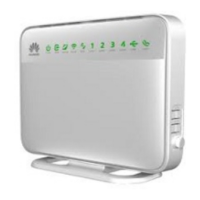
Do you have a question about the Huawei HG658 V2 and is the answer not in the manual?
| Model | HG658 V2 |
|---|---|
| Category | Gateway |
| Wi-Fi Standards | 802.11 b/g/n |
| Frequency Band | 2.4 GHz |
| Ethernet Ports | 4 |
| USB Ports | 1 |
| Wireless Speed | 300 Mbps |
| WLAN | Yes |
| Number of LAN Ports | 4 |
| LAN Port Type | RJ-45 |
| Number of FXS Ports | 2 |
| WAN Ports | 1 x RJ-11 |
| Type | Wireless |
| Security | WEP, WPA, WPA2, WPS |
Overview of the HG658 V2's capabilities and features, including DSL stability and 300Mbps wireless speed.
Details the HG658 V2's ADSL2+/VDSL processor for high-speed internet access.
Explains the HG658 V2's routing capabilities via PPP dial-up or DHCP for multiple device access.
Describes the HG658 V2's support for multiple WLAN protocols and MIMO technology for up to 300Mbps.
Explains how the HG658 V2 manages bandwidth allocation for different computers.
Instructions for setting up wireless connections between devices using the WPS button.
Highlights the built-in firewall's role in protecting against viruses and malicious attacks.
Features for controlling children's computer usage by setting time limits or blocking websites.
Describes the password-protected web-based management pages for personal data protection.
Guidance on choosing an optimal placement for the HG658 V2 for best performance.
Steps for connecting the HG658 V2 to a DSL network using telephone lines.
Instructions for turning on the HG658 V2 and checking the initial status of indicator lights.
How to configure a computer's IP address to enable login to the HG658 V2 management page.
Steps to access and log into the HG658 V2's web interface using the default IP address.
Configuring how the HG658 V2 automatically connects to the internet via various modes.
Guide to establishing wireless connections quickly between the HG658 V2 and WPS-capable devices.
Steps for manually configuring a wireless connection on a Windows computer.
Methods to enable or disable the wireless network function using the button or web page.
How to modify the SSID (WLAN name) and WPA pre-shared key (password) for security.
Methods to enhance wireless network security, including hiding the WLAN name and using strong encryption.
Configuring WLAN access rules to permit only specific computers to connect.
Steps to activate and configure the Wi-Fi Protected Setup (WPS) feature for easy connection.
Setting time-based rules to restrict or allow internet access for specific computers.
Using URL filtering to block access to specific websites on the network.
Managing bandwidth allocation policies for connected computers to ensure fair usage.
Setting up the firewall levels and protections to prevent network attacks.
Setting up a Demilitarized Zone (DMZ) host to expose specific services to the internet.
Blocking or allowing network applications on specific computers based on defined rules.
Setting up port forwarding rules to direct internet traffic to specific internal devices.
Configuring dynamic port opening based on client-initiated requests for specific applications.
Enabling Application Layer Gateway (ALG) functions to ensure correct application layer communication.
Basic explanation of voice communication over Internet Protocol (VoIP) networks.
Steps to set up Voice over IP services and configure VoIP providers and accounts.
Instructions on how to make calls using the configured VoIP service after network connection.
Details on connecting and using USB storage devices like drives and hard disks.
Instructions for connecting USB devices and checking power requirements to avoid malfunction.
Configuring FTP access permissions for USB storage devices to prevent unauthorized access.
Steps to access the FTP server by entering the configured username and password.
How to access the FTP server without authentication by enabling anonymous users.
Using an FTP client to connect and access files on a USB storage device.
Enabling DLNA functionality for media sharing from USB devices to network players.
Setting up a USB printer connected to the HG658 V2 to be accessible over the network.
How to modify the gateway's management IP address to avoid conflicts or for security.
Steps to update login credentials for the web interface to prevent unauthorized access.
Procedures to reset the HG658 V2 to its factory default settings using the reset button or tool.
Instructions for downloading and updating the HG658 V2's firmware from Huawei's official website.
Using the ping utility to check network connectivity and latency between the HG658 V2 and other hosts.
Using the traceroute tool to diagnose network path issues by identifying routers along the route.
Configuring Point-to-Point Protocol over Ethernet (PPPoE) dial-up connection parameters on Windows.
Ensuring that wireless configuration services are enabled in Windows for proper connectivity.
How to find the Media Access Control (MAC) address of a computer's network adapter.
Troubleshooting steps for resolving issues where the HG658 V2 web management interface is inaccessible.
Troubleshooting unsteady wireless connections and intermittent internet access issues with the HG658 V2.
Steps to diagnose and resolve general internet connectivity problems by checking power, WAN, and LAN indicators.
Troubleshooting frequent reboots required for the HG658 V2 to display web pages correctly.
Clarification on the distinct functions of wireless MAC filtering (connection) and general MAC filtering (internet access).
Confirmation that the WLAN password can be changed to improve network security.
Detailed technical data, standards, and specifications for the HG658 V2.
Lists the default configuration parameters for the HG658 V2, including IP addresses and login credentials.